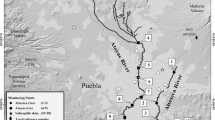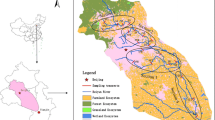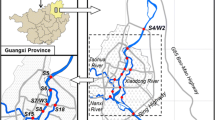Abstract
The concentration of toxic elements (Hg, Cd, Cr, Cu, Pb, Zn, Ni and As) was measured in the sediments of the Qinhuai River in Eastern China along a rural to urban gradient. Multiple approaches were undertaken to evaluate the degree of enrichment and adverse biological effects of these elements. The results showed that the concentration of Hg, Cd, Zn, Cu and Pb increased exponentially from the agricultural headwater to the urbanized downstream, which reflects a severe anthropogenic influence. In addition, area-specific references, such as the local soil background (LSB) and upper continental crust (UCC) derived from the Yangtze craton, were more applicable for evaluating the enrichment of toxic elements in the Qinhuai River than was global UCC. In addition, Cd and Hg had the highest enrichment factor values (EF, with averages of 9.18 and 7.14, respectively); Zn, Pb and Cu had moderate EFs (averages from 1.52 to 2.40), while the average EFs of Ni, Cr and As were approximately equal to 1. Based on consensus-based sediment quality guidelines (SQGs), the contamination characteristics of all of the samples studied were associated with low to moderate priority of adverse biological effects (ABEs) in the rural upstream area, while it was associated with a high to moderate priority of ABEs in the urban sections of the Qinhuai River. Our results suggest that the adverse biological effects of elevated levels of toxic elements were strongly related to the degree of anthropogenic pollution.





Similar content being viewed by others
References
Apeagyei, E., Bank, M. S., & Spengler, J. D. (2011). Distribution of heavy metals in road dust along an urban-rural gradient in Massachusetts. Atmospheric Environment, 45, 2310–2323.
Bain, D., Yesilonis, I., & Pouyat, R. (2012). Metal concentrations in urban riparian sediments along an urbanization gradient. Biogeochemistry, 107, 67–79. doi:10.1007/s10533-010-9532-4.
Burton, J., & Allen, G. (2002). Sediment quality criteria in use around the world. Limnology, 3, 65–76. doi:10.1007/s102010200008.
Cao, Q., Song, Y., Zhang, Y., Wang, R., & Liu, J. (2015). Risk analysis on heavy metal contamination in sediments of rivers flowing into Nansi Lake. Environemental Science and Pollution Research, 1–9. doi:10.1007/s11356-015-4655-8.
Chambers, L. G., et al. (2016). Developing the scientific framework for urban geochemistry. Applied Geochemistry, 67, 1–20. doi:10.1016/j.apgeochem.2016.01.005.
Chen, M., Ma, L. Q., & Harris, W. G. (1999). Baseline concentrations of 15 trace elements in Florida surface soils. Journal of Environmental Quality, 28, 1173–1181.
Cloquet, C., Carignan, J., & Libourel, G. (2006). Isotopic composition of Zn and Pb atmospheric depositions in an urban/periurban area of northeastern France. Environmental Science & Technology, 40, 6594–6600. doi:10.1021/es0609654.
Covelli, S., & Fontolan, G. (1997). Application of a normalization procedure in determining regional geochemical baselines. Environmental Geology, 30, 34–45.
Davis, A. P., Shokouhian, M., & Ni, S. (2001). Loading estimates of lead, copper, cadmium, and zinc in urban runoff from specific sources. Chemosphere, 44, 997–1009. doi:10.1016/S0045-6535(00)00561-0.
Gao, X., & Chen, C.-T. (2012). Heavy metal pollution status in surface sediments of the coastal Bohai Bay. Water Research, 46, 1901–1911.
Gao, S., Luo, T.-C., Zhang, B.-R., Zhang, H.-F., Han, Y.-W., Zhao, Z.-D., & Hu, Y.-K. (1998). Chemical composition of the continental crust as revealed by studies in East China. Geochimica et Cosmochimica Acta, 62, 1959–1975.
Gao, H., Bao, W., & Zhang, S. (2001). A study of pollution chemistry and ecological toxicology in sediment-laden river. Zhengzhou: Yellow River Conservancy Publishing House.
Kara, M., Dumanoglu, Y., Altiok, H., Elbir, T., Odabasi, M., & Bayram, A. (2015). Spatial variation of trace elements in seawater and sediment samples in a heavily industrialized region. Environmental Earth Sciences, 73, 405–421. doi:10.1007/s12665-014-3434-z.
Kaushal, S. S., McDowell, W. H., & Wollheim, W. M. (2014). Tracking evolution of urban biogeochemical cycles: past, present, and future. Biogeochemistry, 121, 1–21. doi:10.1007/s10533-014-0014-y.
Kuusisto-Hjort, P., & Hjort, J. (2013). Land use impacts on trace metal concentrations of suburban stream sediments in the Helsinki region. Finland Science of the Total Environment, 456, 222–230.
Le Pape, P., Ayrault, S., & Quantin, C. (2012). Trace element behavior and partition versus urbanization gradient in an urban river (Orge River, France). Journal of Hydrology, 472, 99–110.
Le Pape, P., Ayrault, S., Michelot, J.-L., Monvoisin, G., Noret, A., & Quantin, C. (2013). Building an isotopic hydrogeochemical indicator of anthropogenic pressure on urban rivers. Chemical Geology, 344, 63–72.
Li, H.-B., et al. (2012a). Urbanization increased metal levels in lake surface sediment and catchment topsoil of waterscape parks. Science of the Total Environment, 432, 202–209.
Li, H., Yu, S., Li, G., & Deng, H. (2012b). Lead contamination and source in Shanghai in the past century using dated sediment cores from urban park lakes. Chemosphere, 88, 1161–1169.
Liao, Q., et al. (2011). Geochemical baseline values of elements in soil of Jiangsu Province. Geology in China, 38, 1363–1378 (in Chinese).
Lin, C., He, M., Liu, X., Guo, W., & Liu, S. (2013). Contamination and ecological risk assessment of toxic trace elements in the Xi River, an urban river of Shenyang city. China Environmental Monitoring and Assessment, 185, 4321–4332. doi:10.1007/s10661-012-2871-y.
Long, E. R., Morgan, L. G. (1990). The potential for biological effects of sediments-sorbed contaminants tested in the National Status and Trends Program. National Oceanic and Atmospheric Admininistration.
Long, E. R., MacDonald, D. D., Severn, C. G., & Hong, C. B. (2000). Classifying probabilities of acute toxicity in marine sediments with empirically derived sediment quality guidelines. Environmental Toxicology and Chemistry, 19, 2598–2601.
Ma, X., et al. (2016). Assessment of heavy metals contamination in sediments from three adjacent regions of the Yellow River using metal chemical fractions and multivariate analysis techniques. Chemosphere, 144, 264–272. doi:10.1016/j.chemosphere.2015.08.026.
MacDonald, D. D., Ingersoll, C. G., & Berger, T. A. (2000). Development and evaluation of consensus-based sediment quality guidelines for freshwater ecosystems. Archives of Environmental Contamination and Toxicology, 39, 20–31. doi:10.1007/s002440010075.
Muller, G. (1969). Index of geoaccumulation in sediments of the Rhine River. GeoJournal, 2, 108–118.
Palma, P., Ledo, L., & Alvarenga, P. (2015). Assessment of trace element pollution and its environmental risk to freshwater sediments influenced by anthropogenic contributions: the case study of Alqueva reservoir (Guadiana Basin). Catena, 128, 174–184. doi:10.1016/j.catena.2015.02.002.
Pejman, A., Nabi Bidhendi, G., Ardestani, M., Saeedi, M., & Baghvand, A. (2015). A new index for assessing heavy metals contamination in sediments: a case study. Ecological Indicators, 58, 365–373. doi:10.1016/j.ecolind.2015.06.012.
Pourabadehei, M., & Mulligan, C. N. (2016). Selection of an appropriate management strategy for contaminated sediment: a case study at a shallow contaminated harbour in Quebec. Canada Environmental Pollution, 219, 846–857.
Reimann, C., & de Caritat, P. (2000). Intrinsic flaws of element enrichment factors (EFs) in environmental geochemistry. Environmental Science & Technology, 34, 5084–5091.
Sansalone, J. J., Hird, J. P., Cartledge, F. K., & Tittlebaum, M. E. (2005). Event-based stormwater quality and quantity loadings from elevated urban infrastructure affected by transportation. Water Environment Research, 77, 348–365.
Singh, M., Müller, G., & Singh, I. B. (2002). Heavy metals in freshly deposited stream sediments of rivers associated with urbanisation of the Ganga Plain. India Water, Air, and Soil Pollution, 141, 35–54. doi:10.1023/A:1021339917643.
Smith, S. L., MacDonald, D. D., Keenleyside, K. A., Ingersoll, C. G., & Field, L. J. (1996). A preliminary evaluation of sediment quality assessment values for freshwater ecosystems. Journal of Great Lakes Research, 22, 624–638.
Taylor, S. R., & McLennan, S. M. (1995). The geochemical evolution of the continental crust. Reviews of Geophysics, 33, 241–265.
Tippler, C., Wright, I. A., Davies, P. J., & Hanlon, A. (2014). The influence of concrete on the geochemical qualities of urban streams. Marine and Freshwater Research, 65, 1009–1017. doi:10.1071/MF13164.
Tomlinson, D., Wilson, J., Harris, C., & Jeffrey, D. (1980). Problems in the assessment of heavy-metal levels in estuaries and the formation of a pollution index. Helgoländer Meeresuntersuchungen, 33, 566–575.
Violintzis, C., Arditsoglou, A., & Voutsa, D. (2009). Elemental composition of suspended particulate matter and sediments in the coastal environment of Thermaikos Bay, Greece: delineating the impact of inland waters and wastewaters. Journal of Hazardous Materials, 166, 1250–1260.
Wicke, D., Cochrane, T. A., O’Sullivan, A. D., Cave, S., & Derksen, M. (2014). Effect of age and rainfall pH on contaminant yields from metal roofs. Water Science and Technology, 69, 2166–2173. doi:10.2166/wst.2014.124.
Wright, I. A., Davies, P. J., Findlay, S. J., & Jonasson, O. J. (2011). A new type of water pollution: concrete drainage infrastructure and geochemical contamination of urban waters. Marine and Freshwater Research, 62(12), 1355–1361. doi:10.1071/MF10296.
Yu, S., et al. (2014). Anthropogenic land uses elevate metal levels in stream water in an urbanizing watershed. Science of the Total Environment, 488–489, 61–69. doi:10.1016/j.scitotenv.2014.04.061.
Yuan, X., Zhang, L., Li, J., Wang, C., & Ji, J. (2014). Sediment properties and heavy metal pollution assessment in the river, estuary and lake environments of a fluvial plain. China Catena, 119, 52–60. doi:10.1016/j.catena.2014.03.008.
Zhao, S., Feng, C., Wang, D., Tian, C., & Shen, Z. (2014). Relationship of metal enrichment with adverse biological effect in the Yangtze Estuary sediments: role of metal background values. Environemental Science and Pollution Research, 21, 464–472. doi:10.1007/s11356-013-1856-x.
Zoller, W. H., Gladney, E., & Duce, R. A. (1974). Atmospheric concentrations and sources of trace metals at the South Pole. Science, 183, 198–200.
Acknowledgements
The Natural Science Foundation of China (NSFC, No. 41271467) supported this work.
Author information
Authors and Affiliations
Corresponding author
Rights and permissions
About this article
Cite this article
Wu, P., Yin, A., Yang, X. et al. Toxic elements in the stream sediments of an urbanized basin, Eastern China: urbanization greatly elevates their adverse biological effects. Environ Monit Assess 189, 167 (2017). https://doi.org/10.1007/s10661-017-5887-5
Received:
Accepted:
Published:
DOI: https://doi.org/10.1007/s10661-017-5887-5




